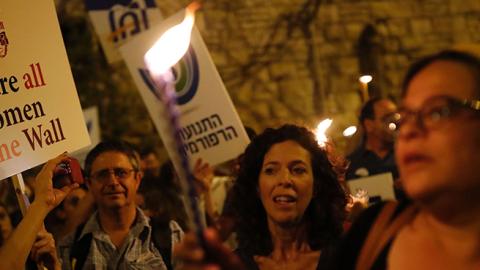In recent days – both in Israel and in Jewish communities in North America – a burning debate has ignited amongst political and religious leaders and has flared up in the media. This argument focuses on Jerusalem’s Western Wall: Who can worship there? Where and how should they worship? What forms of worship are acceptable?
These questions continue to hang uneasily in the holy air over Jerusalem.
For those who aren’t fully aware of Jerusalem’s spiritual geography, a little background about the Western Wall (once known as the “Wailing Wall”) may be helpful.
The Western Wall is called the Kotel in Hebrew. It is virtually all that remains of a retaining wall that was built to support the Temple Mount on which Herod’s magnificent Jewish Temple was constructed.
The Wall is a holy site where Jews, as well as other prayerful people from around the world, offer praise and petitions to God.
In 70 CE, Herod’s Temple was demolished and burned to the ground at the command of Roman Emperor Vespasian, carried out by his son, military commander Titus, and his troops. This followed an agonizing siege, a starvation strategy that all but decimated Jerusalem’s Jews.
Many who somehow survived the siege were slaughtered in the gruesome massacre that followed. Jerusalem was leveled, and its remaining Jewish population was either taken captive by the Romans or somehow desperately straggled into hiding.
Following those terrible days, the Jews who fled – the Diaspora – made their way to nearby lands or faraway places. They were called “Wandering Jews,” because they were never in one place for long before being brutalized or expelled by fanatics – all too often by Christians.
Wherever these Jewish wanderers went, they took with them their holy books, and they carried in their hearts deep sorrow over their destroyed and desecrated city and its Temple. They prayed, generation after generation, that they could one day return to the Holy Mountain: “Next year in Jerusalem…”
Centuries passed. Stories of successful Holy Land pilgrims began to circulate, and there was word of a surviving stone wall that remained intact, where Jews could pray. They not only prayed; they wept in grief for what had been lost, and in gratitude for the holy place they had found.
This was the “Wailing Wall” – where Jews could pound on the gates of heaven, and where the glory of God still seemed to glimmer around them. Surely it was a holy place, a sacred space, where they could pour out their hearts.
Little by little, it was also a place where the vision of Jews returning to Zion flickered into flame.
In the early 20th century, after the destruction of the Ottoman Empire which had long kept a tight rein on Jewish practice, and before the 1967 War, which finally liberated and unified Jerusalem, early photographs bear witness that Jewish men and women unselfconsciously gathered at the Kotel and prayed together. Amanda Borschel-Dan wrote,
From the mid-1800s, photographs of Jews praying together at the Western Wall became common on the walls of houses across the Western world. Today, a rich collection is found in Washington’s Library of Congress digital archives, in which a jumble of Sephardic and Ashkenazi Jews, men and women, are depicted in prayer at what has been considered one of Judaism’s holiest sites for the past two millennia.
Mixed prayer, with men and women praying together, appears to be the norm – or at least a viable option – in these archival images, aside from High Holy Day crushes, in which women either were not in attendance, or prayed off to the side.
Then came the Six-Day War in 1967, and the Jews once again possessed all of Jerusalem – including the Western Wall. In fact, just weeks ago, iconic images of that astonishing military victory appeared as the 50th anniversary of the 1967 War was celebrated.
The Islamic Dome of the Rock and Al Aqsa Mosque have dominated the Temple Mount plaza since the seventh century CE. After June 1967, rabbis warned Jews against walking on the mount’s sacred soil for fear of treading on the site of the biblical Holy of Holies. Some religious leaders forbad all pilgrimages to the Temple Mount, fearing further desecration.
The Western Wall suffered no such restrictions. It was a worship destination for the Jewish faithful, both near and far.
However, as time passed, rabbinical constraints were extended to the Wall, as well. Most notably, it was divided into separate sections for men and women. This reflected the gender separation that is traditional in Orthodox synagogues around the world.
Although men and women had prayed together at the Wall for centuries, it was now forbidden.
Meanwhile, as travel opportunities increased, families began traveling to Israel from abroad to celebrate their children’s Bar Mitzvahs and Bat Mitzvahs at the Kotel. Many of those who observed these rites of passage at the Western Wall belonged to either conservative or reformed Jewish congregations. Therefore, their family events were scrutinized by the watchful eye of the rabbinate, who were determined to maintain ultra-Orthodox Jewish traditions and religious laws at the Wall.
Then, in the 1980s, a new Jewish feminist movement emerged
In 1988, the Women of the Wall (WoW) organization was founded in order to obtain the right for women to pray at the Kotel with Torah scrolls and wearing a tallit (prayer shawl). They did not ask for mixed prayer with men, just a relaxation of the rules concerning how they could pray with other women in the women’s section of the Kotel. This would not violate Orthodox halacha (religious law), but is in opposition to the rules established by the Rabbi of the Kotel and the customs of strictly observant Jews (among others, the prohibition against women chanting out loud in the presence of men).
Although the WoW activists did not initially seek a separate section at the Wall for combined prayer, the obstacle of male and female worship stood in the way of full agreement among Jewish worshippers. Before long, it became a stumbling block between various denominational groups.
In recent months, the WoW issues were addressed in a resolution that approved the construction of a separate worship area, and permitting mixed prayers, women carrying Torah scrolls, wearing prayer shawls and laying tefillin, all overseen by non-Orthodox authorities.
Then, in late June, although construction had already begun to improve access to that section of the Wall, the compromise resolution was abruptly suspended by Prime Minister Benyamin Netanyahu.
At the same time, another law – also shelved at the same time by the prime minister – would have permitted Jews who wish to marry, divorce or be buried in Israel to choose private religious conversions, not supervised by Israel’s ultra-Orthodox rabbinate (presently, those Jews who move to Israel without rabbinical approval of their religious status are required to submit to an ultra-Orthodox conversion process).
So why were two seemingly reasonable resolutions, addressing couple of sticky disagreements, abruptly shelved? The primary reason lies in the not-so-simple way Israel’s democracy works.
Unlike in the U.S., there aren’t two (or three) primary political parties in Israel. There are as many as a dozen small parties or more, all of which must be cobbled into a coalition parliament – the Knesset.
The prime minister – who represents the political party with the most votes – must negotiate with the other parties, great and small, to form a government. This can result in a wobbly and vulnerable coalition – one that can be readily shattered by a smaller but determined minority, most notably ultra-Orthodox political parties.
A shattered coalition inevitably demand new elections.
In this latest upheaval, Netanyahu shelved the two resolutions about the Western Wall for obvious political reasons. He has been widely excoriated by American Jews for this “shameful” decision. But he explained the situation in very concise terms to a troubled group of U.S. envoys representing AIPAC:
“It was either the Kotel or my government.”
Jonathan Tobin explained further:
American Jews need to understand … Israel is a country where there is no separation between religion and state. In such a place, debates on religion are political, not religious. Israel’s political system allows parties like those of the haredi [ultra-Orthodox] community to obtain a disproportionate amount of power. One can’t be surprised when they exercise that power, both to undermine a historic compromise at the Kotel that was first proposed by Jewish Agency Chairman Natan Sharansky, and to exclude other rabbis, including the modern Orthodox, from control of conversions and other policies.
Netanyahu explained his decision to go back on his word by saying that any of his rivals would have done the same. It’s no excuse, but it’s true; it has happened before with Israeli governments on the left, as well as the right.
Netanyahu knew that the ultra-Orthodox parties would remove themselves from his coalition if he allowed the two resolutions to pass. He therefore concluded that he had no choice but to reverse the earlier agreements and maintain a stable Israeli government, even though it guaranteed continuing conflict between warring Jewish religious leaders, both in Israel and the U.S.
And what happens when the postponement ends? Time will tell.
Thankfully, despite occasional demonstrations, and troubled as the atmosphere may be in Israel’s politico-religious world, worshippers including Christians can continue to visit the Western Wall, enjoying it as a place of peace, solace and wonder.
I sometimes go there myself, now and then bearing prayer requests written on bits of paper for loved ones, which I fold up and try to fit into a fissure between the stones.
We Christians are not subject to rabbinical restraints at the Kotel as long as we women dress modestly; our men cover their heads with a kippah or a hat; we observe the men’s and women’s partitions; and we do not practice evangelism.
Otherwise we are free to sit and read a passage of Scripture, or stand and pray in the shadow of the Wall, sometimes pressing an open palm against the cool, ancient stones.
Why pray at the Western Wall if we are not Jewish? We can find good reason in the words of King Solomon, as he dedicated the First Jewish Temple in the 11th century BCE. His prayer carries with it a promise of blessing to all venture there:
Also concerning the foreigner who is not of Your people Israel, when he comes from a far country for Your name’s sake (for they will hear of Your great name and Your mighty hand, and of Your outstretched arm); when he comes and prays toward this house, hear in heaven Your dwelling place, and do according to all for which the foreigner calls to You, in order that all the peoples of the earth may know Your name, to fear You, as do Your people Israel, and that they may know that this house which I have built is called by Your name.















